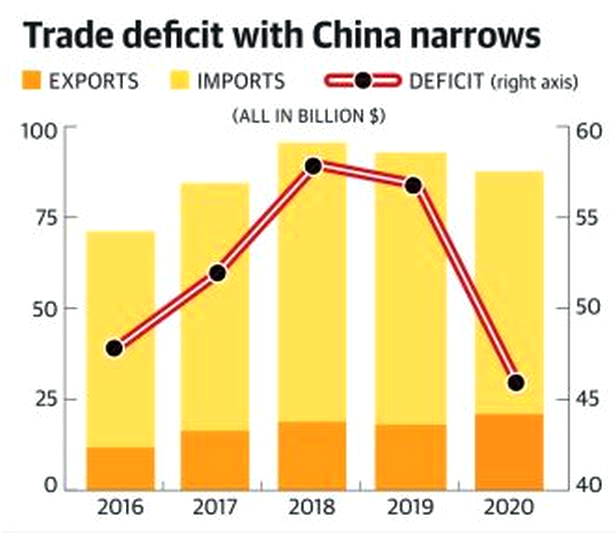India’s Trade Deficit with China at Five-year Low in 2020 | 18 Jan 2021
Why in News
The trade deficit, between India and China, declined to a five year-low of 45.8 billion USD in 2020, the lowest since 2015.
- Trade Deficit: A trade deficit is an amount by which the cost of a country's imports exceeds its exports.
Key Points
- Bilateral Trade in 2020: Two-way trade in 2020 reached 87.6 billion USD, down by 5.6% from 2019, according to new figures from China’s General Administration of Customs (GAC).
- India’s imports from China accounted for 66.7 billion USD, declining by 10.8% year-on-year and the lowest figure since 2016.
- India’s exports to China, however, rose to the highest figure on record, crossing the 20 billion USD mark and growing 16% in 2020.
- Analysis:
- India’s overall imports declined, due to slump in domestic demand in 2020.
- There is, yet, no evidence to suggest India has replaced its import dependence on China by either sourcing those goods elsewhere or manufacturing them at home.
- India’s Biggest Import from China (2019 data):
- Electrical machinery and equipment, organic chemicals fertilisers etc.
- India’s Top Exports to China (2019 data):
- Iron ore, organic chemicals, cotton and unfinished diamonds.
- Further, the year 2020 saw a surge in demand for iron ore in China with a slew of new infrastructure projects aimed at reviving growth after the Covid-19 slump.
- Trade Deficit with China:
- The balance of trade between India and China is hugely tilted in the favour of the latter. India’s trade deficit with China was 45.8 billion USD in 2020 and 56.77 billion USD in 2019.
- The huge trade deficit with China could be attributed to two factors: narrow basket of commodities, mostly primary, that India exports to China and market access impediments for most of Indian agricultural products and the sectors where India is competitive in, such as pharmaceuticals, IT/IteS, etc.
- Over time, India’s raw material-based commodities have been overshadowed by Chinese exports of machinery, power-related equipment, telecom, organic chemicals and fertilisers.
- Measures Taken to Reduce Import Dependence on China:
- The ban on more than 100 Chinese apps, amidst border tensions between the two countries in eastern Ladakh.
- It has increased scrutiny of Chinese investments in many sectors, and is weighing a decision to keep Chinese companies out of 5G trials.
- The government recently put import restrictions on tyres, while also making its prior approval mandatory for foreign investments from countries that share land border with India to curb "opportunistic takeovers" of domestic firms - a move which will restrict FDI from China.
- The Ministry of Commerce and Industry has also identified 12 sectors - food processing, organic farming, iron, aluminium and copper, agro chemicals, electronics, industrial machinery, furniture, leather and shoes, auto parts, textiles, and coveralls, masks, sanitisers and ventilators - to make India a global supplier and cut import bill.
- To cut import dependency on China for APIs (Active Pharmaceutical Ingredients), the government in March approved a package comprising four schemes with a total outlay of Rs. 13,760 crore to boost domestic production of bulk drugs and medical devices in the country along with their exports.

